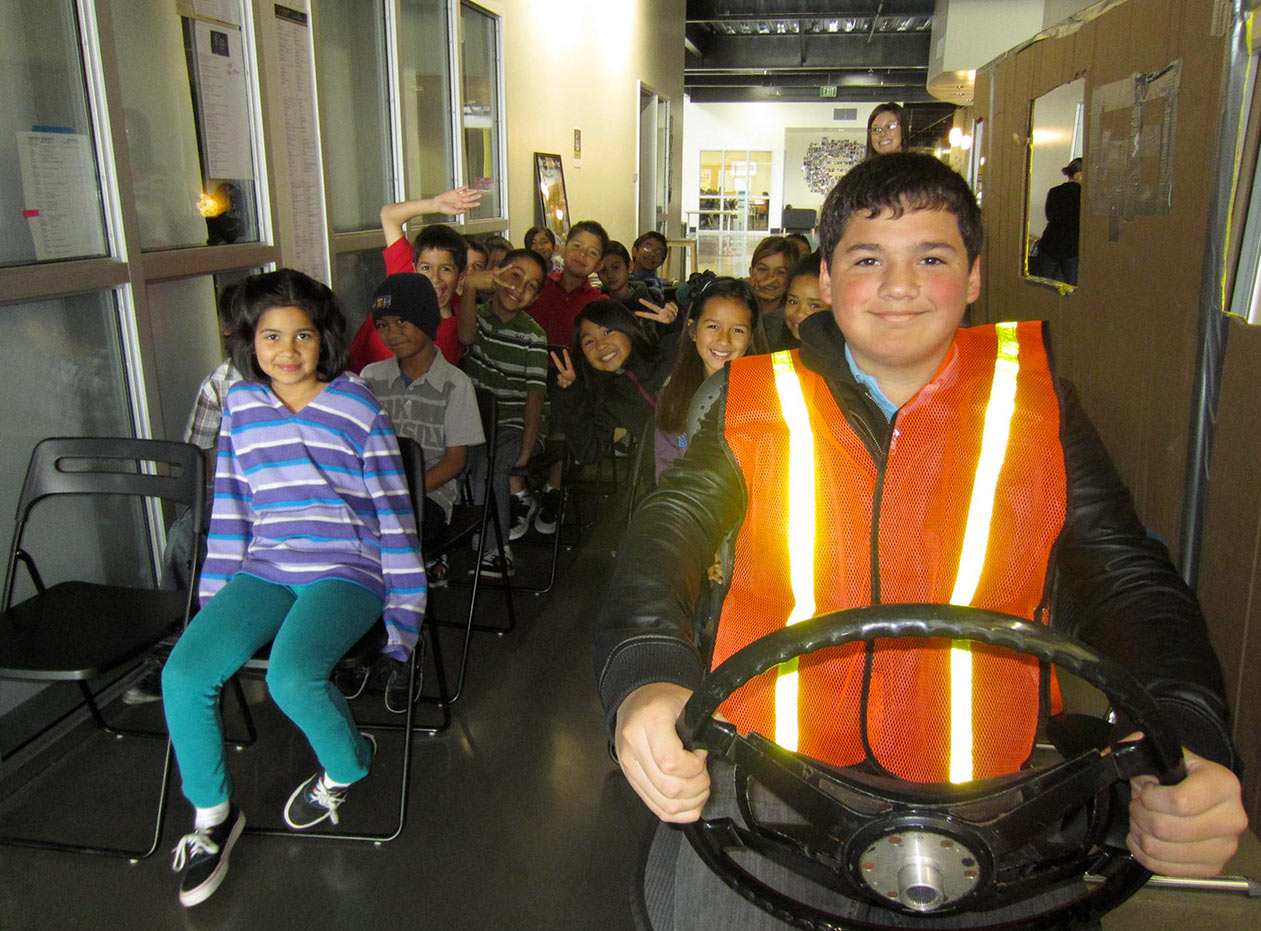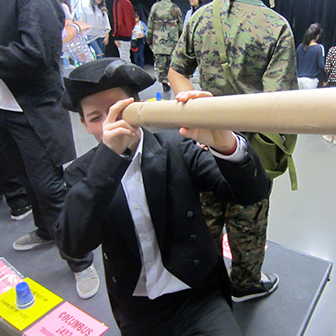Menu
PROJECT DESCRIPTION
INSTRUCTORS
SCHOOL SITE
LEVEL
SUBJECTS

What are the most significant events in U.S. history? What would it be like to travel back in time and experience history as it unfolded?
As a class of 56 8th graders, we first determined the 16 most significant events in U.S. history through a Socratic Seminar discussion. We then constructed a wormhole to travel back in time (via time-traveling bus) in order to experience our chosen events, firsthand, alongside the historical characters and events we researched. We documented our experiences through PhotoShop images and vignettes and compiled them into a Blurb.com book.
– a 164-page published book full of polished, time-traveling vignettes and PhotoShop images (link to full book preview on Blurb.com)
– an interactive exhibition that allowed elementary students to board a cardboard bus, crawl through a wormhole and meet 8th graders (dressed up as the historical figures they met back in time)

Students will know:
Students will understand:
Students will be able to:
Content Topics Addressed
– Dicussion and debate about determining what is historically significant
– Applying the Habits of Mind – S.P.E.C.S. (determining significance, taking on varying perspectives, researching evidence, making connections between historical events and practicing supposition – what if this major event didn’t happen or were changed in some way?)
– 16 Major Events in U.S. history researched, presented on and the 5W’s memorized for a Celebration of Knowledge (i.e. test)
– Research notes for historical events/ using historical accurate research in creative writing
– Writing and Revising
– Using sensory details in writing to bring a historical event to life
Standards Addressed
Students will definitely hit many different parts of the Social Studies content standards for 8th grade, depending on which events they choose. When given the choice to determine significant events as a class, they will inevitably go past where the 8th grade standards end (at Reconstruction and the Industrial Revolution) to more current historical events. The discussion about what the state has determined to be significant Social Studies content standards for an 8th grader could fit very well into this project as you show your class the standards to see for themselves:
8th Grade Social Studies Standards
8.1 Students understand the major events preceding the founding of the nation and relate their significance to the development of American constitutional democracy.
8.2 Students analyze the political principles underlying the U.S. Constitution and compare the enumerated and implied powers of the federal government.
8.3 Students understand the foundation of the American political system and the ways in which citizens participate in it.
8.4 Students analyze the aspirations and ideals of the people of the new nation.
8.5 Students analyze U.S. foreign policy in the early Republic.
8.6 Students analyze the divergent paths of the American people from 1800 to the mid-1800s and the challenges they faced, with emphasis on the Northeast.
8.7 Students analyze the divergent paths of the American people in the South from 1800 to the mid-1800s and the challenges they faced.
8.8 Students analyze the divergent paths of the American people in the West from 1800 to the mid-1800s and the challenges they faced.
8.9 Students analyze the early and steady attempts to abolish slavery and to realize the ideals of the Declaration of Independence.
8.10 Students analyze the multiple causes, key events, and complex consequences of the Civil War.
8.11 Students analyze the character and lasting consequences of Reconstruction.
8.12 Students analyze the transformation of the American economy and the changing social and political conditions in the United States in response to the Industrial Revolution.
8th Grade English Standards
2.0 Reading Comprehension
3.0 Literary Response and Analysis (synthesizing historical research)
1.0 Writing Strategies
2.0 Writing Applications (2.3. Research Reports, 2.1 Short Stories)
1.0 Listening and Speaking Strategies (1.4 Prepare a Speech Outline)


Required Materials and Tools
Required
– Computers for writing and revising work
– Access to textbooks or online research
– Materials and costumes for building interactive exhibition back in time (tunnel for wormhole, etc.)
Optional
– PhotoShop (although, cutting out student photos and gluing them into historical photos could be a way to achieve a similar outcome without PhotoShop)
– Green Screen/ Green Sheet or painted wall along with iMovie (this is optional for a fun iMovie activity)
– inDesign (also optional – other programs could be used to layout the book, including Blurb.com’s free program BookSmart)
Timeline
STEP 0 (~1 Day w homework the night before) (Before the Start of the Project): Students are assigned a homework assignment of compiling the 10 most significant events in their lives, so far. When they arrive in class the next day, they are asked to cut that list down to the three most significant events that they write on three different notecards. Then, they form two group – boys and girls. They are given 15 minutes to build a timeline of major events with notecards, paperclips and string. The number of events included should be less than the total number of events being brought forward by the group. This should help the students start thinking about which major events make it into the history books, and which don’t. The quieter or more timid students during the activity may not get their lives represented at all, unless a louder voice speaks up for them. The students and observations could be recorded for the activity and applied to the process of determining significant events in U.S. history.
STEP 1 (~3 Days): A Socratic Seminar to determine what our team (of two classes) considered the Most Significant Events in history.
Each student researched what he/she considered the three most significant events in U.S. history. This completed handout was required for participation in our Socratic Seminar: MajorEventsSPECS
Socratic Seminar Handouts: Socratic Seminar – Expectations for ALL, Inner Circle Response Prompts, and SocraticSeminarFeedback
STEP 2 (~2 Days): Make final choices on which events will make our list of most significant events in U.S. history.
Example list of our 16 Most Significant Events with brief definitions by student groups:MostSignificantEventsVocab and MostSignificantEventsVocabDefined
STEP 3 (~1 Day): Students form groups of four who are most interested in specific events. Students compete for points by getting answers right from the U.S. history portion of the U.S. Citizenship Test. Those points give some students more capital as they compete to sign up for the events they are most interested in researching and “traveling back in time” to experience.
STEP 4 (~3 Days): Together, students research the 5W’s of their chosen events and the S.P.E.C.S. (habits of mind: significance, perspective, evidence, connections and speculation)
Handout: MajorEventsSPECS (Before students completed their SPECS about their major event in U.S. history, they practiced and received feedback on applying SPECS to a major events in their personal lives: SPECStopersonalevent)
STEP 5 (2 Weeks): We chose a title for our book and began discussing our audience. As a teacher, I created a handout for the project with requirements, a calendar and examples of the fact sheet and time-traveling vignettes each student was beginning to write.
Project Handout with requirements, calendar, book intro and example writing pieces: StaffClass2thePast Project Handouts
Research guide for student vignettes (visiting a specific person in history associated with the chosen event): SignificantPersonResearch
Inserting yourself back in time using PhotoShop: PlacingYourselfInHistoryWithPhotoShop
Project Extensions and Real World Connections
This project is meant to build foundational understanding of major events in U.S. history, along with challenging students to begin questioning how we determine an events “significance” in the grand scheme of history. The published book and interactive exhibition were both inegral parts of the project, but could also be seen as extensions. After understanding and researching different perspectives on signficant events, the hope is that students will take that critical thinking skill and apply it to understanding differing perspectives on current events.
Resources
Handouts
StaffClass2thePast Project Handouts Packet of Handouts for Students
Rubrics
SCTTP SPECS Reflection at the End of the Project
Teacher resources
Teacher:
“Sometimes, it can be challenging to get my students (and myself) excited about researching major events in U.S. history, but time-travel was a great hook. One of my students came up with the idea of traveling through a worm hole and using gummy worms to come back to our time-traveling bus. I loved hearing all of the creative ideas come out during this project as students planned where they would travel back in time and who they would meet in the context of their chosen historical event. We brought history alive by imagining ourselves traveling back in time into it, and I think creating the PhotoShop images and using the green screen brought more fun and enthusiasm to the project. I really enjoyed traveling through time alongside my students.”
– Cady Staff, 8th grade Humanities teacher, HTMCV
Student:
“What inspired us to write a book about time travel? On a Monday morning our humanities teacher, Ms. Staff, came into class more excited than usual. She began to explain a dream she had over the weekend. In her dream, the entire eighth grade class went back in time with her to visit the 16 most important events in U.S. history. At first we thought she was kidding; then we realized she was serious! She was serious about making this our next history project. Thus, the time travelling began. We split into groups and chose our important events in history. Through careful and deliberate research, each person in the group wrote a vignette about their “experience” with an important historical character from the past. We put them all together and… Voila! Our book was ready. Ready for editing that is. That’s where our role came in. We spent countless hours re-reading and editing, looking for grammatical errors, accuracy and clarity. Each one of us read and edited rough drafts countless times before we felt it was perfect.”
– Excerpt from Staff Class to the Past Student Editors’ Introduction: Kyla Getzel, Phyllis Kuroda Crawford, Juan Sánchez, Nayeli Diez de Bonilla, Alexis Azhocar and Jessica Guevara